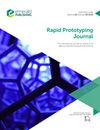Multiplanar continuous fiber reinforcement in additively manufactured parts via co-part assembly
IF 3.6
4区 工程技术
Q1 ENGINEERING, MECHANICAL
引用次数: 0
Abstract
Purpose Many additively manufactured parts suffer from reduced interlayer strength. This anisotropy is necessarily tied to the orientation during manufacture. When individual features on a part have conflicting optimal orientations, the part is unavoidably compromised. This paper aims to demonstrate a strategy in which conflicting features can be functionally separated into “co-parts” which are individually aligned in an optimal orientation, selectively reinforced with continuous fiber, printed simultaneously and, finally, assembled into a composite part with substantially improved performance. Design/methodology/approach Several candidate parts were selected for co-part decomposition. They were printed as standard fused filament fabrication plastic parts, parts reinforced with continuous fiber in one plane and co-part assemblies both with and without continuous fiber reinforcement (CFR). All parts were loaded until failure. Additionally, parts representative of common suboptimally oriented features (“unit tests”) were similarly printed and tested. Findings CFR delivered substantial improvement over unreinforced plastic-only parts in both standard parts and co-part assemblies, as expected. Reinforced parts held up to 2.5x the ultimate load of equivalent plastic-only parts. The co-part strategy delivered even greater improvement, particularly when also reinforced with continuous fiber. Plastic-only co-part assemblies held up to 3.2x the ultimate load of equivalent plastic only parts. Continuous fiber reinforced co-part assemblies held up to 6.4x the ultimate load of equivalent plastic-only parts. Additionally, the thought process behind general co-part design is explored and a vision of simulation-driven automated co-part implementation is discussed. Originality/value This technique is a novel way to overcome one of the most common challenges preventing the functional use of additively manufactured parts. It delivers compelling performance with continuous carbon fiber reinforcement in 3D printed parts. Further study could extend the technique to any anisotropic manufacturing method, additive or otherwise.增材制造零件的多平面连续纤维增强
目的:许多增材制造的零件存在层间强度降低的问题。这种各向异性必然与制造过程中的取向有关。当零件上的各个特征具有相互冲突的最优方向时,零件不可避免地会受到损害。本文旨在展示一种策略,在这种策略中,相互冲突的特征可以在功能上分离成“合作部件”,这些“合作部件”分别以最佳方向排列,有选择地用连续纤维增强,同时打印,最后组装成性能大大提高的复合部件。设计/方法/方法选择几个候选部件进行协同分解。它们被打印成标准的熔融长丝制造塑料部件,在一个平面上用连续纤维增强的部件,以及带和不带连续纤维增强(CFR)的部件组件。所有部件都装好了,直到失效。此外,代表常见的次优导向特性(“单元测试”)的部件也被类似地打印和测试。正如预期的那样,scfr在标准件和合作部件组装中都比非增强塑料部件有了实质性的改进。增强部件承受的极限载荷是等效纯塑料部件的2.5倍。合作策略带来了更大的改善,特别是当也用连续纤维增强时。纯塑料合作部件组件可承受等效纯塑料部件的3.2倍极限载荷。连续纤维增强的合作部件组件可承受相当于仅塑料部件的6.4倍的极限载荷。此外,本文还探讨了通用协同部件设计背后的思考过程,并讨论了仿真驱动的自动化协同部件实现的愿景。原创性/价值这种技术是克服阻碍增材制造零件功能使用的最常见挑战之一的新方法。它提供了令人信服的性能与连续碳纤维增强的3D打印部件。进一步的研究可以将该技术扩展到任何各向异性制造方法,添加剂或其他方法。
本文章由计算机程序翻译,如有差异,请以英文原文为准。
求助全文
约1分钟内获得全文
求助全文
来源期刊

Rapid Prototyping Journal
工程技术-材料科学:综合
CiteScore
8.30
自引率
10.30%
发文量
137
审稿时长
4.6 months
期刊介绍:
Rapid Prototyping Journal concentrates on development in a manufacturing environment but covers applications in other areas, such as medicine and construction. All papers published in this field are scattered over a wide range of international publications, none of which actually specializes in this particular discipline, this journal is a vital resource for anyone involved in additive manufacturing. It draws together important refereed papers on all aspects of AM from distinguished sources all over the world, to give a truly international perspective on this dynamic and exciting area.
-Benchmarking – certification and qualification in AM-
Mass customisation in AM-
Design for AM-
Materials aspects-
Reviews of processes/applications-
CAD and other software aspects-
Enhancement of existing processes-
Integration with design process-
Management implications-
New AM processes-
Novel applications of AM parts-
AM for tooling-
Medical applications-
Reverse engineering in relation to AM-
Additive & Subtractive hybrid manufacturing-
Industrialisation
 求助内容:
求助内容: 应助结果提醒方式:
应助结果提醒方式:


